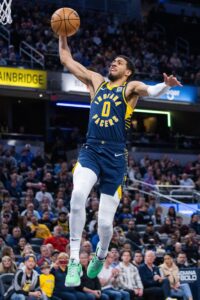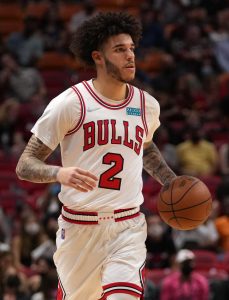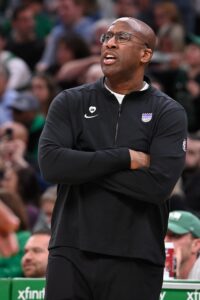The term “base year compensation” no longer shows up in the NBA’s Collective Bargaining Agreement and hasn’t since 2011. A relic of past agreements, the base year compensation rule was intended to prevent teams from signing free agents to new contracts that were specifically intended to facilitate salary-matching in trades.
While the base year compensation rules have, for the most part, been adjusted and/or removed from the CBA, there’s still one situation where they apply. Teams have to take them into account when completing sign-and-trade deals.
The BYC rules apply to a player who meets all of the following criteria in a sign-and-trade:
- He is a Bird or Early Bird free agent.
- His new salary is worth more than the minimum.
- He receives a raise greater than 20%.
- His team is at or above the cap immediately after the signing.
If the player meets those criteria and is included in a sign-and-trade deal, his outgoing salary for matching purposes is considered to be his previous salary or 50% of his new salary, whichever is greater. For the team he is being signed-and-traded to, his incoming figure for matching purposes is simply his new full salary.
Here are a couple specific examples to help make things a little clearer:
 Let’s say the Knicks want to sign-and-trade OG Anunoby this offseason. There’s no indication they do, but the likely salary gap between his current contract and his next one make him a good example of a base year compensation player. Anunoby is a Bird free agent, his new salary will be well above the minimum, and New York projects to be an over-the-cap team. Having made $18,642,857 in 2023/24, Anunoby figures to receive a raise significantly higher than 20% — his next deal could easily start above $30MM. So he meets the BYC criteria.
Let’s say the Knicks want to sign-and-trade OG Anunoby this offseason. There’s no indication they do, but the likely salary gap between his current contract and his next one make him a good example of a base year compensation player. Anunoby is a Bird free agent, his new salary will be well above the minimum, and New York projects to be an over-the-cap team. Having made $18,642,857 in 2023/24, Anunoby figures to receive a raise significantly higher than 20% — his next deal could easily start above $30MM. So he meets the BYC criteria.
In a scenario where he signs a deal with a $38MM starting salary as part of a sign-and-trade, Anunoby’s salary for matching purposes from the Knicks’ perspective would be $19MM, which is 50% of his new salary (that amount is greater than his previous salary). From his new team’s perspective, Anunoby’s incoming figure would be his actual salary, $38MM.
On the other hand, if Anunoby were to get a starting salary worth $35MM from a new team, his outgoing salary for matching purposes would be $18,642,857, the amount he made in 2023/24, because that figure would be higher than 50% of his new salary ($17.5MM).
Often, a team acquiring a player via sign-and-trade doesn’t have the cap room to sign the player outright, or else there would be little incentive to negotiate a sign-and-trade. That means salary-matching is required, which can be complicated by base year compensation rules.
In the first Anunoby scenario outlined above, the Knicks wouldn’t be able to take back more than $26.5MM in salary in exchange for the forward due to the league’s matching rules. That number would dip to $19MM if New York’s team salary is above the tax apron. However, in order to take on $38MM in incoming salary, New York’s hypothetical trade partner – assuming they’re over the cap – would have to send out at least $30.2MM in order to account for those salary-matching rules themselves.
The gap between the salary-matching figures from the two teams’ perspectives would complicate sign-and-trade talks, requiring the two clubs to include additional pieces or get a third team involved to make the numbers work.
There were a few examples last summer of teams navigating base year compensation rules to complete sign-and-trade deals. For instance, when the Celtics signed-and-traded Grant Williams to the Mavericks, he met the BYC criteria when he received a raise far above 20%, getting $12,405,000 in the first year of his new contract.
That meant Dallas had to match his incoming $12.4MM salary (and did so sending out Reggie Bullock‘s $11MM+ salary to San Antonio in the three-team deal), but for Boston’s purposes, Williams’ outgoing cap figure was just $6,202,500, half of his new salary. The Celtics didn’t take back any players in the three-team swap, but created a trade exception worth that amount.
The Heat took a similar path when they signed-and-traded Max Strus to the Cavaliers. Strus’ first-year salary on his new deal with Cleveland was $14,487,684, which was the amount the Cavs had to account for when they salary-matched, but it only counted as $7,243,842 in outgoing salary for the Heat, who created a trade exception worth that amount.
In order to legally acquire Strus, the Cavs sent out Cedi Osman ($6,718,842) and Lamar Stevens (whose deal featured a $400,000 partial guarantee). They were permitted to take back up to 200% of that outgoing salary, plus an extra $250K. It’s no coincidence that if you take those two cap figures ($7,118,842), double them ($14,237,684) and add that $250K cushion, the end result is $14,487,684, Strus’ exact salary.
The base year compensation concept doesn’t surface all that often, due to the specific criteria that must be met. However, it looms large over sign-and-trade attempts involving free agents who receive significant raises, reducing the likelihood of teams finding a deal that can be legally completed.
Note: This is a Hoops Rumors Glossary entry. Our glossary posts will explain specific rules relating to trades, free agency, or other aspects of the NBA’s Collective Bargaining Agreement. Larry Coon’s Salary Cap FAQ was used in the creation of this post.
Previous versions of this post were published in 2019, 2022, and 2023.
 1:40pm: Pacers point guard
1:40pm: Pacers point guard  “Yes, I firmly believe that,” said Ball, who hasn’t played in an NBA game since January 14, 2022. “That’s the plan that I’m on and I haven’t had any setbacks, so I expect to play the first game.”
“Yes, I firmly believe that,” said Ball, who hasn’t played in an NBA game since January 14, 2022. “That’s the plan that I’m on and I haven’t had any setbacks, so I expect to play the first game.” Brown received a four-year contract when he was hired by Sacramento during the 2022 offseason, but only three years of that deal are guaranteed — the fourth is a mutual option, meaning both sides would have to opt in. That option wasn’t exercised, according to
Brown received a four-year contract when he was hired by Sacramento during the 2022 offseason, but only three years of that deal are guaranteed — the fourth is a mutual option, meaning both sides would have to opt in. That option wasn’t exercised, according to